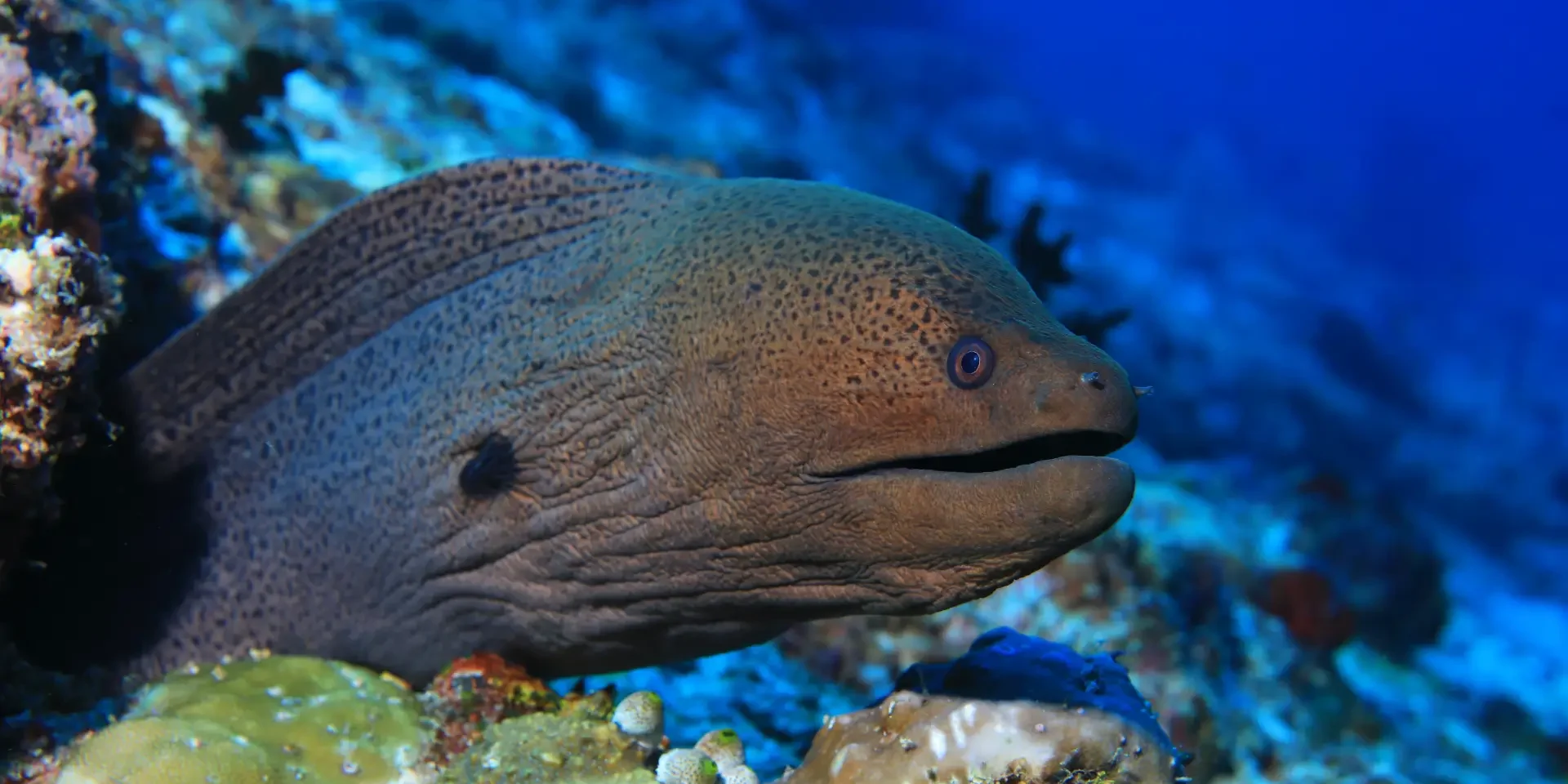Of course! Here is a detailed article about the mysterious and captivating moray eel, featuring a special section on Bohol, Philippines, as requested. The article is presented without any hyperlinks for easy use.
The Serpent of the Sea: Unmasking the Mysterious Moray Eel
Lurking within the labyrinthine crevices of the coral reef is a creature of myth and legend. With a serpentine body, a powerful jaw, and an intense, unblinking stare, the moray eel is the enigmatic recluse of the underwater world. Often cast as the villain in ocean tales, the moray is one of the most misunderstood residents of the reef. In reality, it is a shy, fascinating, and vital part of the marine ecosystem.
Forget the vibrant exhibitionists and the gentle giants; an encounter with a moray eel is a dive into the reef’s hidden lairs. It’s a patient game of hide-and-seek that rewards the observant diver with a glimpse of a truly primeval and captivating predator. So, let’s pull back the curtain on the moray eel and shine a light into the shadows they call home.
More Than Just a Menacing Mouth
To appreciate the moray, you must first look past its intimidating appearance. These are not sea serpents, but a diverse family of eels (Muraenidae) with over 200 species, each uniquely adapted to its environment.
- The Gaping Gaze: A moray eel is almost always seen with its mouth agape. This isn’t a sign of aggression; it’s simply how they breathe. By constantly opening and closing their mouths, they pump water over the gills located in their throat, a process known as buccal pumping.
- A Slimy Secret: Morays lack the protective scales of most other fish. Instead, their thick, leathery skin is coated in a layer of toxic mucus. This slime layer not only protects them from parasites and abrasion as they navigate sharp coral, but it can also be poisonous to predators who try to take a bite.
- Two Sets of Jaws: In a feature straight out of a sci-fi movie, moray eels possess a second set of jaws in their throat called pharyngeal jaws. When a moray bites its prey with its primary jaws, this second set launches forward, grabs the meal, and pulls it back into the esophagus for swallowing. This allows them to consume large prey in tight spaces where they can’t create suction.
- A Symphony of Symbiosis: Look closely at a moray, and you may spot a brave cleaner shrimp or cleaner wrasse darting in and out of its mouth. This is a classic example of symbiosis. The moray gets a thorough dental cleaning, removing parasites and dead skin, while the cleaner gets a free meal and protection from other predators.
A World Tour of Eel Encounters
Moray eels are found in tropical and temperate seas worldwide, wherever they can find rocky or coral-rich environments to hide in. A patient diver can find them almost anywhere, but some locations are particularly renowned for their eel populations.
Bohol, Philippines: A Haven for Macro and Morays
The island of Bohol, located in the heart of the Visayas region of the Philippines, is a world-famous diving destination. While whale sharks in other parts of the country might grab the headlines, Bohol is a paradise for those who love the intricate details of the reef—and it is a spectacular place to find moray eels.
The reefs surrounding islands like Panglao, Cabilao, and Anda are incredibly rich and diverse. The sheer density of coral growth creates an almost infinite number of nooks and crannies, which is the perfect real estate for morays. On a single dive in Bohol, it’s not uncommon to spot multiple species. You might find a large Giant Moray peering out from under a table coral, its massive head a formidable sight. Look closer into the smaller cracks, and you might spot the beautiful black and yellow latticework of a Snowflake Moray. Divers often find White-eyed Morays sharing holes, their pale eyes glowing in the torchlight. The dive sites are so full of life that morays are often seen cohabitating with other creatures, offering incredible photographic opportunities of their symbiotic relationships with cleaner shrimp. The health of Bohol’s reefs means the entire food chain is robust, providing plenty of food and ensuring a thriving, visible moray population for divers to respectfully observe.
Other Global Hotspots:
- The Red Sea: The vibrant reefs of Egypt and Jordan are famous for their massive Giant Morays and stunningly patterned Masked Morays. The excellent visibility makes spotting them a rewarding experience.
- The Caribbean: The coral gardens of locations like Bonaire and the Cayman Islands are prime territory for the iconic Green Moray. Despite its name, this eel is actually brown; its eerie green hue comes from the layer of toxic mucus covering its skin.
- Indonesia and Malaysia: The heart of the Coral Triangle, places like Raja Ampat and Sipadan, boast incredible biodiversity. Here you can find a dazzling array of eels, from the intricately spotted Honeycomb Moray to the elusive and highly sought-after Ribbon Eel, which changes color from black to electric blue to yellow as it matures.
A Rogues’ Gallery: The Many Faces of the Moray
The moray family is incredibly diverse, with members ranging from a few inches to giants over 10 feet long.
- Giant Moray (Gymnothorax javanicus): The heavyweight champion. As the largest moray by mass, its thick, muscular body and leopard-spotted pattern make it an impressive sight on Indo-Pacific reefs.
- Snowflake Moray (Echidna nebulosa): A smaller, more peaceful species popular in the aquarium trade. Its beautiful pattern of black and yellow star-like blotches makes it a favorite find for night divers.
- Zebra Moray (Gymnomuraena zebra): A truly unique eel with a short, blunt snout perfect for crushing its preferred prey of crustaceans. Its striking black-and-white striped body gives it its name.
- Blue Ribbon Eel (Rhinomuraena quaesita): A spectacle of nature. This slender eel is a protandric hermaphrodite. It starts life as a black juvenile, matures into a vibrant blue male with a yellow dorsal fin, and can finally transform into a fully yellow female.
Demystifying the Danger: An Undeserved Reputation
Moray eels have a reputation for being aggressive and dangerous, but this is largely undeserved. They are shy, reclusive creatures that would much rather hide than fight. Nearly all recorded “attacks” on humans are defensive. A moray will only bite if it feels threatened and cornered, or if a hand is mistakenly thrust into its hole. Their eyesight is quite poor, and they rely heavily on their powerful sense of smell to hunt at night. A prodding finger can easily be mistaken for a struggling fish.
The golden rule when diving with morays is simple: look, but don’t touch. Give them their space, never reach into crevices, and simply appreciate them from a respectful distance. By doing so, you’ll see them for what they truly are: not monsters of the deep, but masterful predators and essential custodians of the reef’s health. To find a moray is to be granted an audience with one of the ocean’s most ancient and intriguing characters, a silent guardian in a serpentine cloak.







